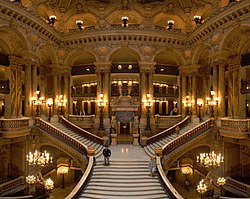Top: The Grand staircase of the Palais Garnier (Paris), 1860–1875, by Charles Garnier; Second: The CEC Palace on Victory Avenue (Bucharest, Romania), 1897–1900, by Paul Gottereau;[1] Third: Entrance of the Grand Palais (Paris), 1900, by Charles Girault; Bottom: Grand Central Terminal and the New York Central Building (New York City), pictured in 1944. |
Beaux-Arts architecture (/boʊz ˈɑːr/ bohz AR, French: [boz‿aʁ] ) was the academic architectural style taught at the École des Beaux-Arts in Paris, particularly from the 1830s to the end of the 19th century. It drew upon the principles of French neoclassicism, but also incorporated Renaissance and Baroque elements, and used modern materials, such as iron and glass, and later, steel. It was an important style and enormous influence in Europe and the Americas through the end of the 19th century, and into the 20th, particularly for institutional and public buildings.
- ^ Marinache, Oana (2017). Paul Gottereau – Un Regal în Arhitectură (in Romanian). Editura Istoria Artei. p. 184. ISBN 978-606-8839-09-7.



